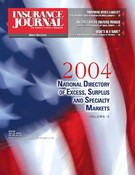Wireless can make sense because you can be mobile while still being connected to the agency’s network. Now the information is at the producer’s fingertips.
The insurance industry seems to have embraced wireless communications for its method of out-of-the-office computing. It is a hugely popular means of transmitting data, with millions of wireless Internet subscribers’ worldwide and global revenues estimated in the billions of dollars.
Wireless communication is the transfer of electromagnetic signals from place to place without cables, usually using radio waves. Radio waves travel freely in all directions and are inherently non-private. Think of a wireless network, using radio waves, being comparable to someone having physical access to your wired network.
Wireless can make sense because you can be mobile while still being connected to the agency’s network. Producers like using personal digital assistants (PDAs) and smart pagers. With these portable, handheld tools, agency personnel can sell and service customers on the spot. No more driving back to the office to pick up a quote or access a file. Now the information is at the producer’s fingertips. Wireless communications is also useful for telecommuters and virtual agencies. Employees can access the agency server for customer data from any remote location.
Another benefit is cost. It’s less expensive—and takes less time—to install a wireless network than the traditional wired local area network (LAN) or wide area network (WAN). With wireless, there’s no need to pull cable through your office building for connectivity. It’s also easier to relocate a wireless network. You don’t have to consider whose workstation will be where in a new environment. Nor do you have to reconfigure your network cabling when you rearrange your office or move to a new building.
But there are some tangible security risks associated with the wireless agency, because there is no physical way to keep radio waves from being picked up by receivers other than the intended ones. Wireless networks by default broadcast a service set identifier (SSIS) several times per second. This identifier allows computer hackers to know all about your wireless network.
A new type of computer theft is war driving. War driving is the act of locating and exploiting connections to a wireless LAN, while driving around a community. For war driving, all a thief needs is a vehicle, a computer, a wireless Ethernet card and some type of antenna. With this inexpensive combination of equipment, your wireless network is now vulnerable to being used as a free Internet connection for a computer hacker. Or, worse, your agency’s confidential information could be stolen.
Besides being vulnerable to security attacks from war drivers and other computer hackers, a wireless network does not encrypt data. Encryption is the act of converting information into a code so that it is unreadable. A secret key or password is necessary to decode or unscramble the information. For example, most secure and reputable Web sites encrypt your credit card number when you make an online purchase so that when it is transmitted over the network, it cannot be read by hackers. The card number is unscrambled (decrypted) when the data reaches its intended recipient.
Another area of concern is the integrity of your network. Just like unmanaged desktop systems, handheld devices are susceptible to viruses and worms. These can be passed onto your agency’s server and network without proper virus protection, routers and firewalls. The wireless access point, which is the bridge between the wireless network (with PDAs and other handheld devices) and your wired network at the agency, has a blank password. Most wireless network users do not take the time to assign a password, which makes all of your data extremely vulnerable to war drivers. In fact, they could log in, set a password and lock you out of your own wireless network.
As a business person, you must weigh not only the benefits but the risks of going wireless. Your agency’s computer system faces more risks of being hacked with a wireless network, which means your confidential customer data is vulnerable. It also adds other layers of complexity in keeping the information synchronized with the main database and protecting from worms and viruses.
If, after weighing all of the pros and cons, you are still determined to provide point-of-sale and point-of-service to your customers, make sure to implement a complex and strong password at your wireless access point. This means not using a common name, your pet’s name or anything else that is easily penetrated.
Also, purchase wireless communications software and products that meet the Federal Information Processing Standards (FIPS), which are the security and privacy standards for the federal government’s computer systems. This includes software that encrypts the data flowing back and forth on the wireless network. And hire an expert who can help your wireless network stay safe.
LuNell Gilliland is the co-founder of True West Solutions Inc., an on-site network and desktop computer services company in Southern California. She can be reached at (818) 346-2128 or visit www.truewestsolutions.com.
Topics Cyber
Was this article valuable?
Here are more articles you may enjoy.


 MAPFRE Accuses AAA of Violating Long-Time Exclusive Marketing Agreement
MAPFRE Accuses AAA of Violating Long-Time Exclusive Marketing Agreement  Georgia Republicans Move to Scrap State Income Tax by 2032 Despite Concerns
Georgia Republicans Move to Scrap State Income Tax by 2032 Despite Concerns  Wildfires, Storms Fuel 2025 Insured Losses of $108 Billion: Munich Re Report
Wildfires, Storms Fuel 2025 Insured Losses of $108 Billion: Munich Re Report  SIAA Announces Strategic Partnership With Progressive
SIAA Announces Strategic Partnership With Progressive 


